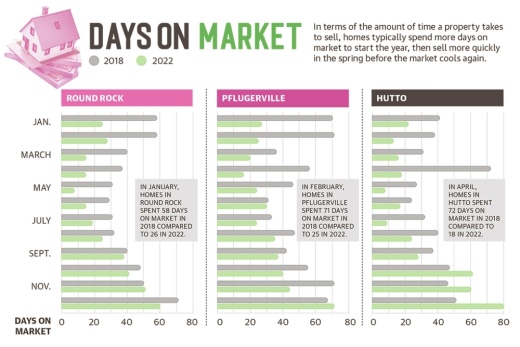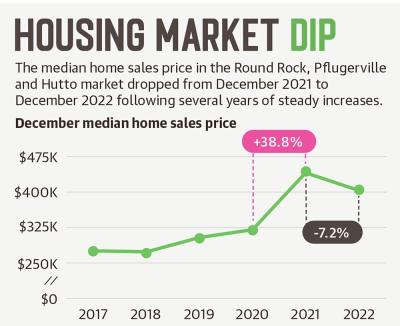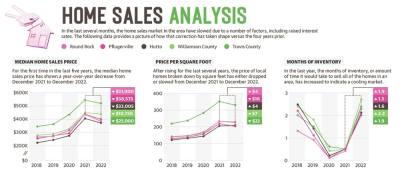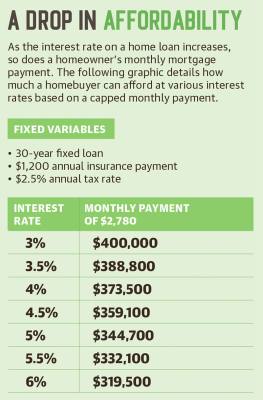In these three cities, home prices fell by more than 7% from December 2021 to December 2022, according to data from the Austin Board of Realtors. The dip follows several years of steady home valuation increases that culminated in a 39% increase from December 2020 to December 2021.
Area experts attribute the drop to a number of factors, including rising interest rates for financing, buyer fatigue and continuing supply chain issues.
However, industry professionals are also predicting that Central Texas home markets will return to steady year-over-year price increases in the next 18 months to two years as interest rates will likely go back down.
One thing most experts agree on: The last few years in the Central Texas home market have been unparalleled.
“The [COVID-19] pandemic [caused] the most unusual market I’ve ever seen,” said Rob Tiemann, who develops the Blackhawk master-planned community in Pflugerville. “Nobody has ever seen anything like it. Prices went up at unprecedented rates, and the interest rates were super low. Well, now interest rates are up.”
A cooling market
Ashley Jackson, president of the Austin Board of Realtors, said in spring 2022 she had a listing in Round Rock that was selling for about $400,000.
Jackson said there was a line out the door for the open house on that property, and she ended up receiving more than 30 offers that were well above the asking price.
That scenario represents a stark contrast to the market of late 2022 and early 2023, she said.
“I just closed a listing in Round Rock a few weeks ago that sat on the market for over two months,” Jackson said.
Even though the home market in 2021 and 2022 was still showing rapid home sales price increases throughout Central Texas every month, Jackson said it was much more attractive to buyers when interest rates were still hovering around 3%.
Now that interest rates within the home lending market have roughly doubled since September 2021, Jackson said not only are hundreds of dollars being added to monthly mortgage payments, but other factors are slowing the market as well.
In June 2022, a home for sale in Pflugerville spent an average of 24 days on the market. By December, that average jumped to 71, according to data from ABOR.
Within the same timeframe in Round Rock the average days on market went from 19 to 60, and in Hutto that figure skyrocketed from 9 to 80.
Though homes sales numbers can be seasonal—March through June typically show higher sales according to real estate professionals—the average days on market in 2022 was much more volatile than previous years.
For example in 2018, homes in Hutto spent an average of 24 days on market in June and 51 in December.
Another indicator of the slowed market is the amount of home inventory. The Texas A&M Real Estate Center defines this metric as the number of active listings in a given market divided by the average number of sales per month during the prior 12 months. As the number of days homes spend for sale increase, the market continues toward what real estate professionals term balanced.
Michele Sherwood, a Realtor for Keller Williams who services Williamson, Travis and Bastrop counties, said in the Austin area, a balanced market will have about three months of inventory.
In the Round Rock, Pflugerville and Hutto combined market, months of inventory was at 2.1 months in December. In December 2021, it was at 0.5 months.
Existing home sales appear to have been hit a little differently than the new home market, according to Tiemann, who said builders will continue to add homes in the Blackhawk neighborhood until 2040.
New home prices have dropped recently throughout the industry, but that was not necessarily due to higher interest rates, he said.
“Homebuilders in general have reduced prices, but they were able to do that, one, because the market was more competitive, and two, because some of the materials costs were coming down,” Tiemann said.
Sherwood said buyer fatigue also played a role in the slowing market. As home prices and demand exploded starting in late 2021 and early 2022, the sheer volume of competition for a property made the market inaccessible for most buyers.
With so many properties receiving dozens of offers at tens of thousands of dollars over the asking price, most buyers became weary, she said.
“At some point, people just have to throw their hands in the air and say, ‘I don’t want to play this game anymore,’” Williams said.
A long-term return to normal
Austin resident Micah Vickers said he and his wife developed buyer fatigue when trying to buy a home in the area, including in Round Rock during the height of the COVID-19 pandemic.
He said he became more and more discouraged as home prices started soaring in 2021 and pretty much gave up trying by the end of 2022.
“I’m not saying that I can’t, as a new homebuyer, break into the market,” Vickers said. “I just don’t know how long it’s going to take to do that. I guess the rate that I’m seeing, the market is going down now, but it’s going to go right back up. That’s what it does.”
Vickers said he still sometimes looks at home-selling websites, but he and his wife have become so discouraged by Central Texas home prices they are planning to move out of Texas.
Max Leaman, who runs an Austin-based home lending company called LoanPeople, said even with home prices dropping, higher interest rates for people who finance homes have actually raised monthly mortgage costs.
For prospective homebuyers, like Vickers, who were struggling to break into the market when rates were hovering around 3%, a modest dip in prices now—when rates are closer to 6%—is not going to change the cost situation for the better, Leaman said.
As one example, he said a home loan of $500,000 at 4.5% interest would have amounted to a $2,534 monthly payment on principal and interest. At a 6.1% interest rate, which is about where the base rate stood in early January, a $400,000 home loan would be about the same monthly cost.
However, in addition to helping to lower home prices, he said rising interest rates have other benefits for buyers, including more negotiating power.
Leaman also said even though higher rates have scared off a lot of buyers and cooled the market, now is actually an ideal time to buy a home while prices are dipping. Homeowners can always refinance as rates come back down.
Because the base interest rate for home lenders is in many ways connected to the consumer price index, which measures the overall rate of inflation, Leaman said interest rates will start dropping along with inflation. He predicts that will continue to happen over the next couple of years.
“As rates come down, you will see buyers lose negotiating power, and prices will go up,” he said. “The reason being that [is] as rates continue to fall, there will be more demand.”








